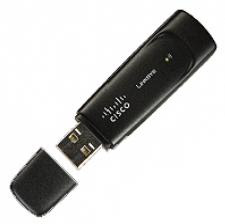I need to agree that my use case was a bit uncommon, but the impact was a bit too much. The first thing that I had to do after installing the Cisco Wireless Client (called CWC from now on) was to uninstall it. This is why:
I bought a USB wifi dongle from Cisco (was a linksys product) to use it on my EEEBox.

As explained in my earlier post, the idea was to use this wifi dongle as an end-point for internet/intranet access in my home. I connected from my laptop to my EEEBox via VNC over the existing wifi connection. The dongle's box insists on installing the software first before I plug in the hardware into the comp -- possibly for simplicity and to avoid user errors. I remotely mounted the CD (remember? EEEBox doesn't have a CD drive) and started the install. As I started, I was starting to think about how this software is going to handle an existing wifi card which doesn't belong to Cisco. The software didn't show any sign of detecting such a card. At this point, I was calling that as 'seamless' integration!! but that thought didn't last so long. The installation proceeds and reaches the end and my VNC viewer closes!! I was a bit shocked with this behavior, but was hoping that the new wifi client will initialize and get back, and I should soon see my EEEBox back on my wifi network -- but it never happened. As I have static mapping (MAC->IP) on my DHCP server, I knew the IP that it would get every time. Clearly it had gone for a toss!! Then I rebooted the EEEBox using the hardware button on the case and watch the display on my TV. I realized there was an issue (Note: I haven't plugged in my cisco wifi dongle yet). The CWC started up but it was not able to connect to the network -- and the reason: authentication failure. CWC had only picked up my SSID from Windows but not any other credentials (WEP key in my case). This is half-baked migration. If it was not possible to read such credentials from Windows client, it should have at least warned me that it couldn't do so or have asked me for the credentials again! Ok, I forgave and reconfigured the settings on CWC and got it connected to my network. As I thought, I was all done but just plug in the USB dongle, I had a surprise waiting. The moment I connected the USB dongle, the CWC detects the new interface, installs the required drivers and brings it active. BUT, disables the old wireless connection!!! This sucks! defeats my whole purpose. I later realized that CWC doesn't allow two wifi connections (for that matter, any two network connections) at the same time -- at least that software that I got with this dongle didn't! Simplicity at the cost of functionality? I didn't have to think again, just uninstalled CWC instantly. Thankfully, this time, the software did what I expected. It didn't uninstall my wifi dongle drivers, but only the client software. So, one reboot, the Windows wireless client takes over, with both my wifi network interfaces active! Sigh!! Windows resurrected me from something else, for the first time ;)

